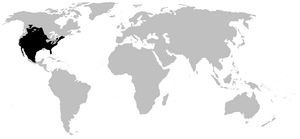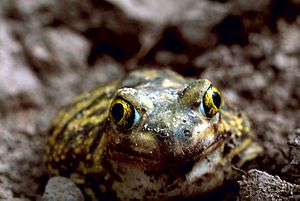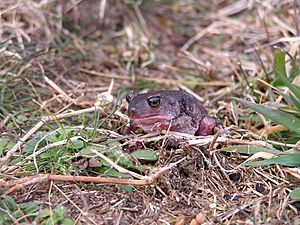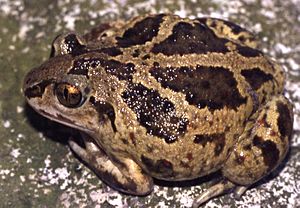American spadefoot toad facts for kids
Quick facts for kids American spadefoot toad |
|
|---|---|
 |
|
| Western spadefoot toad (Spea hammondii) | |
| Scientific classification |
|
| Kingdom: | Animalia |
| Phylum: | Chordata |
| Class: | Amphibia |
| Order: | Anura |
| Suborder: | Mesobatrachia |
| Family: | Scaphiopodidae Cope, 1865 |
| Genera | |
|
Scaphiopus |
|
 |
|
| Distribution of Scaphiopodidae (in black) | |
The American spadefoot toads are a small family of toads. They are found only in North America. There are only seven different types, or species, of these special toads.
These toads are shaped like most frogs that dig. They have round bodies, short legs, and eyes that stick out. Their name "spadefoot" comes from a hard, bony part on their feet. This part helps them dig into the ground. Like most digging frogs, they dig backwards. They are different from "true toads" because they have vertical pupils in their eyes. They also do not have parotoid glands, which are glands true toads have behind their eyes.
American spadefoot toads live on land when they are not underground. They are usually dull colors like grey, green, or brown. This helps them hide in their dry homes.
Contents
What are American Spadefoot Toads?
American spadefoot toads are about 2 to 3 inches long. They have round, strong bodies and eyes that bulge out. The "spade" on their back legs is a hard, bony part. It helps them burrow into the soil. Their skin is smooth and usually grey or brown.
Where Do They Live?
Spadefoot toads usually live in dry places. They spend most of their lives underground. They often hide under ponds, creek beds, or other wet areas. When there is enough rain, the toads come out to breed and lay eggs.
Different types of spadefoot toads live in different parts of North America.
- The eastern spadefoot is the only type found east of the Mississippi River. It lives from New England down to southern Florida.
- The Great Basin spadefoot and plains spadefoot live in Western Canada and the northwestern U.S. The plains spadefoot also lives in Texas and northern Mexico.
- Couch's spadefoot, Hurter's spadefoot, and the New Mexico spadefoot live across the Southern and Southwestern U.S. Couch's and Hurter's also reach into Mexico.
- The western spadefoot is found only in California and parts of Mexico.
Scientists believe these toads moved to North America from South America. This happened because the climate changed. They likely came as one species. Then, they split into different types as they spread out and got used to their new homes. These toads like marshy places. But they only go into the water to breed. They stay buried in the soil most of the year. This helps them deal with changing weather.
What Do They Eat?
American spadefoot toads have a unique diet. What they eat changes as they grow. Adult toads eat small animals without backbones. These include flies, crickets, caterpillars, moths, spiders, centipedes, millipedes, earthworms, and snails.
Tadpoles' diets depend on where they live and what food is around. When they first hatch, they eat tiny water plants and animals called plankton. After a few days, they start eating other small animals. Sometimes, tadpoles even eat each other to survive.
Researchers found that tadpole growth depends on how long water stays in an area. Spadefoot toads breed in shallow waters. This means they often face stress from drying water, rising heat, less food, and crowded spaces. This stress, or not enough food, can make them eat each other. If they do this, their bodies can change. They grow bigger heads, sharp beaks, stronger jaw muscles, and shorter intestines. Scientists think this helps them grow faster by getting more food.
Protecting Spadefoot Toads
Some spadefoot toads are in danger. The eastern spadefoot was put on the endangered list in Pennsylvania in 2005. This means there were very few left. One reason for low numbers is that breeding pools often dry up. This happens before the tadpoles can fully change into frogs.
Efforts are being made to save their homes. For example, in 2012, a couple learned that land they wanted to build on might be spadefoot toad habitat. They then had to get state approval. They also needed to hire an expert to check the land for toad habitats. This shows how people are becoming more aware.
In 2004, the western spadefoot toad was listed as "near threatened." This was by the ICUN Red List, which tracks endangered species. All other spadefoot species were listed as "least concern" at that time. Now, all species' protection status needs to be checked again.
Types of Spadefoot Toads
| Name | Biological name | Description | Images |
|---|---|---|---|
| Couch's spadefoot toad | Scaphiopus couchii | Couch's spadefoot toads live in the southwestern U.S. and parts of Mexico. They stay buried for 8–10 months a year. They can eat enough in one meal to last a whole year! Their tadpoles turn into frogs in just 7–8 days. | |
| Eastern spadefoot toad | Scaphiopus holbrookii | Eastern spadefoot toads live along the East Coast of the U.S. They are found from southern New England to Florida. They mostly live in marshes and swamps. They can grow up to 3 inches long. | |
| Great Basin spadefoot toad | Spea intermontanus | The Great Basin spadefoot toad lives from British Columbia, Canada, to northwestern U.S. states like Wyoming and California. Most are active at night. They eat small animals like ants. | |
| Hurter's spadefoot toad | Scaphiopus hurterii | Hurter's spadefoot toads live in the Southern U.S. states of Texas, Arkansas, Oklahoma, and Louisiana. People once thought they were a type of eastern spadefoot toad. | |
| New Mexico spadefoot toad | Spea multiplicata | The New Mexico spadefoot toad lives in Mexico and U.S. states like Arizona, New Mexico, and Utah. It grows up to 2.5 inches long. | |
| Plains spadefoot toad | Spea bombifrons | The plains spadefoot toad lives in Canada's southern prairies, central U.S. states, and northern Mexico. They can grow up to 2 inches long. They are found in sandy or gravelly soils near temporary water. | |
| Western spadefoot toad | Spea hammondii | The western spadefoot toad lives only in California and Baja California, Mexico. Unlike some other toads, it only goes into the water to breed. |
See also
 In Spanish: Sapos pata de pala para niños
In Spanish: Sapos pata de pala para niños





